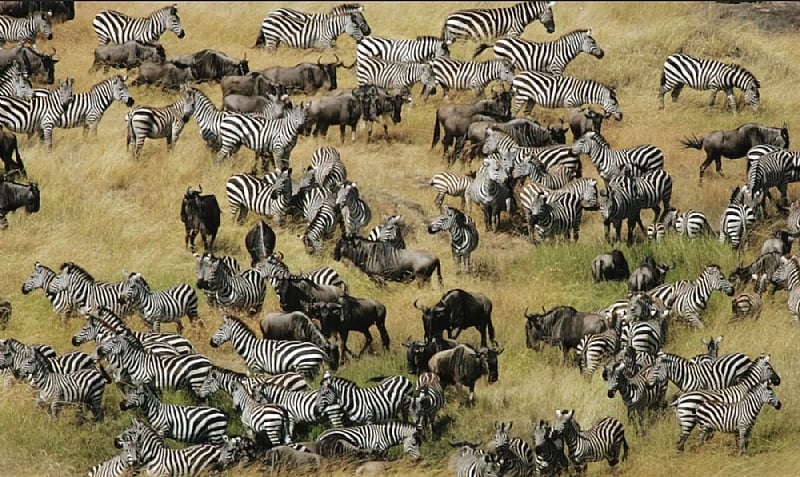Africa, a continent teeming with biodiversity and breathtaking landscapes, offers an unparalleled safari experience. From the vast plains of the Serengeti to the intimate encounters in Mole National Park, the continent boasts a diverse range of national parks, each with its unique charm and wildlife spectacles. This expanded guide delves deeper into the unique features of five exceptional national parks, providing a comprehensive overview for prospective travelers.
The Serengeti National Park in Tanzania, a UNESCO World Heritage site, is renowned for hosting the Great Migration, a breathtaking spectacle where millions of wildebeest, zebras, and gazelles traverse the plains in search of greener pastures. This annual event attracts a plethora of predators, including lions, leopards, and cheetahs, creating a dramatic display of the circle of life. Beyond the migration, the Serengeti boasts an astonishing concentration of wildlife, with over 500 bird species and the highest density of large predators globally. The park’s vastness allows for a truly immersive experience, where visitors can witness the raw beauty of nature unfold before their eyes, from the thrill of a cheetah’s hunt to the serene beauty of a sunrise over the savanna.
Bordering the Serengeti, the Masai Mara National Reserve in Kenya offers an equally captivating safari experience. Famous for its dramatic river crossings, where wildebeest and zebras brave crocodile-infested waters during the Great Migration, the Mara provides heart-stopping wildlife encounters. The reserve is also home to the iconic Marsh Pride of lions, made famous by the BBC’s “Big Cat Diary,” offering visitors the chance to observe these majestic creatures in their natural habitat. Furthermore, the Masai Mara provides a unique opportunity for cultural immersion, allowing visitors to interact with the Maasai people and learn about their rich traditions. It’s important to note that only registered tour vehicles are permitted within the park, ensuring a controlled and sustainable tourism environment.
Kruger National Park in South Africa stands out for its exceptional infrastructure and accessibility. As one of Africa’s largest and oldest game reserves, Kruger offers a well-developed road network, making it ideal for self-drive safaris. This allows for a personalized and flexible exploration of the park’s diverse landscapes, ranging from savanna to woodlands and riverine forests. Home to an impressive 147 mammal species, over 500 bird species, and all members of the “Big Five,” Kruger provides ample opportunities for wildlife sightings and photography. The southern section of the park is particularly renowned for its high concentration of lions and leopards.
Nairobi National Park in Kenya offers a unique juxtaposition of wildlife and urban landscapes. Located just minutes from Kenya’s capital city, the park provides the surreal experience of observing lions against the backdrop of skyscrapers. Despite its relatively small size, Nairobi National Park boasts a remarkable diversity of wildlife, serving as a successful rhino sanctuary and home to four of the “Big Five” (excluding elephants). Visitors can encounter lions, leopards, buffaloes, giraffes, zebras, and a myriad of bird species, making it a convenient and rewarding safari destination for those with limited time or seeking a quick escape from the city.
Venturing to West Africa, Mole National Park in Ghana presents a distinct safari experience. As Ghana’s largest wildlife refuge, Mole is a haven for elephants, offering unparalleled opportunities to observe these gentle giants in their natural habitat. The park is also home to buffalo, kob, roan antelope, and various primate species. What sets Mole apart is its emphasis on walking safaris, allowing for intimate and up-close encounters with wildlife. Accompanied by experienced guides, visitors can immerse themselves in the park’s natural beauty and experience the thrill of encountering animals on foot. With over 300 bird species, Mole is also a paradise for bird enthusiasts.
These five national parks represent just a fraction of the incredible safari experiences that Africa has to offer. Each park provides a unique window into the continent’s remarkable biodiversity and offers opportunities for transformative encounters with wildlife. Whether witnessing the grandeur of the Great Migration, observing lions against a city skyline, or tracking elephants on foot, a safari in Africa is an unforgettable adventure that connects visitors with the raw beauty and power of the natural world. The diverse landscapes, from expansive savannas to dense forests, provide a backdrop for unforgettable moments and memories that will last a lifetime. Careful planning and research are essential to ensure a safe and rewarding safari experience. Choosing the right time of year, booking accommodations and tours in advance, and understanding park regulations are crucial steps in maximizing the journey. Furthermore, engaging with local communities and respecting their cultures adds a deeper dimension to the safari experience, fostering a greater appreciation for the delicate balance between humans and wildlife. A safari in Africa is not merely a vacation; it’s a journey of discovery, a chance to connect with nature on a profound level, and a reminder of the importance of conservation efforts to protect these precious ecosystems for future generations.


